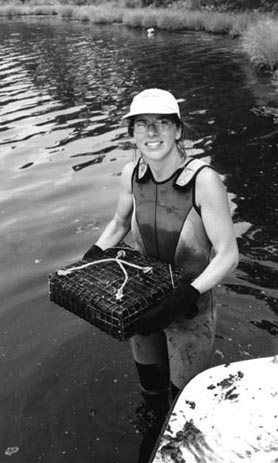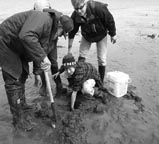
|
How
One Thing (Nitrogen) Leads to Another (Shellfish Growth)
Understanding how one thing leads to another is an important part of science. Unfortunately, cause and effect relationships can be complicated. Just ask Ruth Carmichael, who recently earned her doctorate for studies on the effects of nitrogen (N) loading on shellfish. Supported in part by Woods Hole Sea Grant, Carmichael's work—focusing on two Cape Cod estuaries—highlights the consequences of urbanization, a trend seen worldwide.
Above:
On Cape Cod, wastewater—traveling through groundwater—is
the primary source of nitrogen to coastal embayments. Biologist
Ruth Carmichael investigated the impacts of excess nitrogen
on shellfish. Photo by Andrea
Shriver, BU Marine Program
Changing land usage and increasing populations are both causes and effects of urbanization that threaten coastal resources by increasing nitrogen inputs from atmospheric deposition, fertilizers, and wastewater. More nitrogen leads to increases in algae in the water column and an accumulation of organic matter in the sediments, decreasing oxygen in near-bottom waters. Studies by Carmichael's advisor, Ivan Valiela, and fellow lab-mates at the Boston University Marine Program, have demonstrated effects of excess nitrogen, including changes in benthic species and finfish communities.
But what happens to the shellfish? Carmichael reasoned that higher N loads would increase food supply; more food means less competition for food; and more food should lead to increased shellfish growth. Still, research by the Valiela group and others shows that N loading increases the potential for eutrophication and degraded habitats—conditions that should decrease shellfish survival. She wondered: how would these conflicting effects play out?
To get a feel for her starting point, Carmichael compared shellfish landings by permit from two periods: 1955‚1980 and 1980‚present. On Cape Cod, she found a 40 percent decrease in landings for quahogs (Mercenaria mercenaria) and a 60 percent decline for soft-shell clams (Mya arenaria). Similarly, she found declines in soft-shell landings in Rhode Island (48 percent) and Maine (69 percent). Scallop (Argopecten irradians) landings declined 40 percent overall, from Rhode Island, Maine, and Massachusetts.
Those data, from the National Marine Fisheries Service's Fisheries Statistics and Economics Division and the Massachusetts Department of Marine Fisheries, correlate with N loading increases. "We know eutrophication plays a role," explains Carmichael, "but how does that relate to what our fishermen are bringing home? Is that decline in landings related to eutrophication? We can't say with certainty," she says, "but it does raise concerns, even if it's just one of several potential contributing factors."
Carmichael selected eight field sites in which to study the N loading effects on shellfish food supply and habitat. The estuaries, in Buzzards Bay and Waquoit Bay, offered a range of N loads. In each, Carmichael sampled a series of parameters including chlorophyll a concentration (a proxy for food supply), carbon and nitrogen content, and organic vs. inorganic matter in suspended particles and sediment. Carmichael also measured dissolved oxygen, Eh (a proxy for oxygen availability in the sediments), sediment grain size, temperature, and salinity.
Carmichael observed an increase in chlorophyll a concentrations as N loads increased. "This finding, along with other data, such as a decrease in the carbon to nitrogen ratio, points to an increase in the amount and quality of food available to shellfish as N loads increased." Her data, however, also showed that sediments and near bottom waters may have been oxygen-depleted when chlorophyll a concentrations were highest during her study.
"While the primary effects of N loading appear to be that the clams are reaching maximum size faster," says Carmichael, "I wanted to determine if there were any other secondary effects of nutrient enrichment that might ultimately limit the potential for growth, despite increased food supply. Is there a point at which N loading begins to limit or depress growth?" Carmichael did not find a threshold at which excess food supply was a growth-limiting factor in the estuaries she sampled, though salinity was another story. In the two estuaries where clams showed depressed growth, salinity measurements were frequently less than 20 parts per thousand. "This has the potential to limit the growth-enhancing effects of a larger food supply," she explains, "presumably because in low salinity conditions, the animals pump food from the water column less rapidly and thus feed less efficiently. They can't take advantage of the higher food supply." To find out more about clam feeding behavior, Carmichael examined stable isotope signatures of carbon and nitrogen, sampling water column and sediment food sources. Increased N loading did not seem to affect how the clams processed the food, though Carmichael found that the clams appeared to be more selective about what they were eating. Her data suggest that, even though there was more overall food available, N loading may change the relative abundance of different food particles. "As it turns out," says Carmichael, "N-enriched estuaries have relatively fewer food components assimilated—and perhaps preferred or selected—by shellfish." Carmichael's results have raised a few eyebrows in the coastal management community, and she is careful to point out that her work should not be taken out of context. "Nitrogen is an important estuarine resource," she says. "It stimulates primary production—the 'green stuff'—and secondary production—in this case, shellfish that eat the 'green stuff'; it's a natural part of the system. Finding a balance between the conflicting effects of increased nitrogen loading to coastal embayments is an important management consideration," she says. Carmichael would like to see her data applied to shellfish management and the aquaculture industry, as well as further research on food web analyses. She has taken her results on the road, speaking at public lectures and meetings, and on local television and radio programs. The next stop on Carmichael's tour is Machias, Maine, where she recently began a new job as Assistant Professor of marine biology at the University of Maine. The position, half teaching and half research, seems a perfect fit for someone so adept at making sense of how one thing leads to another—and why.
|

